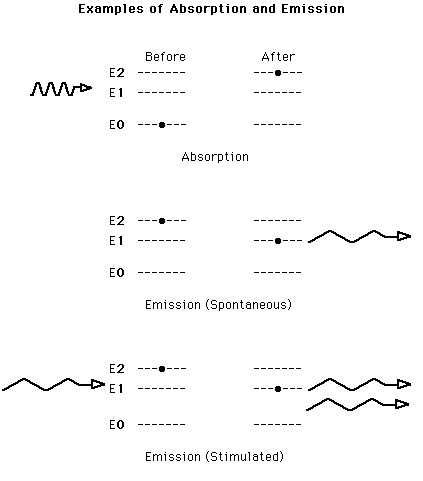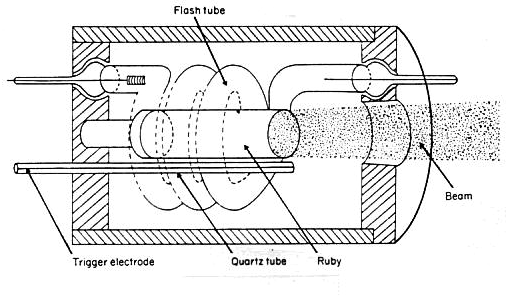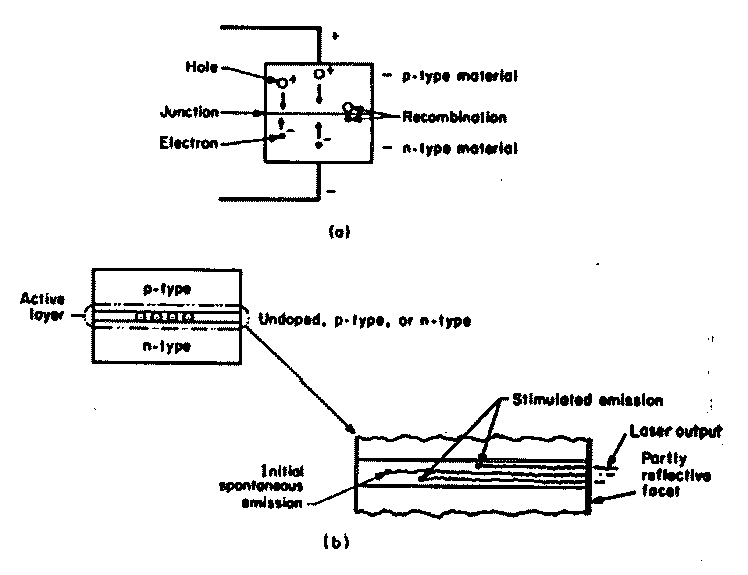
Donald J. Farmer
djfarmer@sonic.net
January 15, 1997
 |
(Missing pictures will be included when available. M.C.)

Energy levels in a helium-neon laser.
Some of the 30 possible laser transitions are shown by solid lines with arrows. An electric discharge exites both the helium and neon atoms. Collisions between them transfer energy from exited helium to neon atoms having essentially the same energy level. Laser emission is one of the steps as the excited neon atoms release energy in going toward the ground state. The strongest laser transition is at 633 nm.

The first He-Ne laser (late 1960). It produced beams at infrared wavelengths of 1118, 1153, 1160, 1199 and 1207 nm.

Schematic representation of the first ruby laser. Pulses of coherent light at 692.9 nm were obtained in mid-1960. Ruby is a crystal of aluminum oxide, containing a small amount of chromium oxide.

Internal design of a modern sealed He-Ne laser tube.

Energy levels in a ruby laser.
The laser transition occurs in triply ionized chromium. The flash lamp exites chromium ions to the broad levels identified by the circled 3. Ions in the lower of these two levels transfer energy to the level circled 2 by a radiationless process. The result is a population inversion between circled 2 and the ground state, circled 1. The transition labeled R1 is the laser radiation.

Operation of a laser diode (simplified).
(a) Forward bias produces current flow and recombination.
(b) Stimulated emission in the active layer.

Read head of a CD player.
The laser diode emits at 780 nm, which is beyond the visible range.

Laser disk-type amplifier.
In the Nova laser, the disks are glass having a small amount of neodymium. Disk shape is elliptical, major axis of about is 30 in.
(a) Side view. (b) End view.
What Happened to the Maser?
Whatever uses were envisioned for the maser, none proved practical. There was always a better way to do what was wanted, either with then current technology, or with the fruits from rapidly advancing technology. This may be understood, in part, in that microwave techniques were fairly well developed by the time the maser arrived, and there were active and continuing programs to improve them.
Two examples: i) The maser as a low noise microwave amplifier, and ii) The maser as a precision frequency standard. The first was displaced by the field-effect transistor. Attempts to realize a practical embodiment of the second were beset with problems for which there seemed to be no ready solution.
Expanding on the latter, based on considerations of line width alone, the output frequency of an atomic hydrogen maser should be stable and reproducible to about one part in ten to the fourteenth. This is six to seven orders of magnitude better than frequency standards existing at the time. And, three orders of magnitude better than today's standard, the passive cesium beam device. One of the main things that doomed the hydrogen maser was wall effects, in which a collision of an excited atom with the cavity wall affects its transition frequency. Another was cavity pulling. The frequency at which the system oscillates is influenced by how closely the microwave cavity in tuned to the natural frequency of the maser transition. Even with a cavity made of Invar, and temperature control, sufficient precision was not achieved.
Several hydrogen maser frequency standards were built. It was said of them that it took ten PhD's to get one up and running, and another five to keep it running
References
The literature on masers and lasers is plentiful. For this talk I have relied mostly on the items cited below, along with my own recollections.
Mario Bertolotti: Maser & Lasers. An Historical Approach. Adam Hilger Ltd., Bristol, 1983. [A very readable treatment of basic theories. Brief biographical sketches of the principal players adds a personal touch to the presentations. Has an extensive bibliography of early work in the field.]
Jeff Hecht: The Laser Guidebook. McGraw Hill, Inc., New York, Second Edition, 1992. [An excellent source of practical information about numerous laser types, and their commercial embodiments. Good bibliography.]
Jeff Hecht: Laser Pioneer Interviews. High Tech Publications, Inc. Torrance, 1985. [ Interviews with scientists and engineers who played key roles in the birth of the laser industry.]
Return to January Report